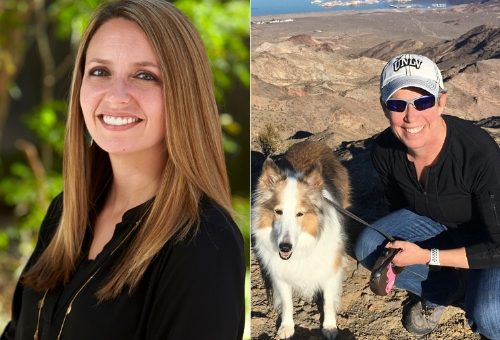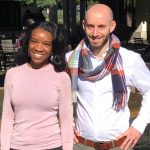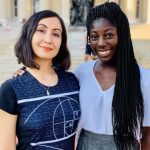Are drivers of more expensive cars really the jerks we make them out to be? In Episode 73, Courtney Coughenour and Jennifer Pharr from the University of Nevada, Las Vegas discuss their research into what differentiates drivers who are likely to yield for pedestrians in crosswalks from those who don’t. Their open access article, “Estimated car cost as a predictor of driver yielding behaviors for pedestrians,“ was published along with multiple co-authors on February 18, 2020 in the Journal of Transport & Health.
Websites and other resources
- Courtney’s ResearchGate page
- Jenny’s ResearchGate page
- Video from their experiments:
Bonus Clips
Patrons of Parsing Science gain exclusive access to bonus clips from all our episodes and can also download mp3s of every individual episode.
Support us for as little as $1 per month at Patreon. Cancel anytime.
🔊 Patrons can access bonus content here.
We’re not a registered tax-exempt organization, so unfortunately gifts aren’t tax deductible.
Hosts / Producers
Ryan Watkins & Doug Leigh
How to Cite
Music
What’s The Angle? by Shane Ivers
Transcript
Courtney Coughenour: They make it across the road nine times out of ten. But in the event that they don’t it’s likely to be catastrophic.
Ryan Watkins: This is Parsing Science: the unpublished stories behind the world’s most compelling science, as told by the researcher themselves. I’m Ryan Watkins.
Doug Leigh: And I’m Doug Leigh. Today, in episode 73 of Parsing Science, we’ll talk with Courtney Coughenour and Jennifer Pharr from the University of Nevada, Las Vegas, about their research which found that each additional $1000 in a car’s value, the odds that their owners will yield to pedestrians is reduced by 3%. Here are Courtney Coughenour and Jenny Pharr.
Coughenour: Hello, I’m Courtney Coughenour I’m an assistant professor at the UNLV School of Public Health. I grew up in Pittsburgh, Pennsylvania, and I completed my undergraduate degree at Penn State University. I then moved to Las Vegas, Nevada to get my masters and PhD at UNLV and I never left.
Jennifer Pharr: So hi, I’m Jenny Pharr. I’m an associate professor in the Public Health at the University of Las Vegas, Nevada, I grew up in Houston, Texas and received. My bachelor’s degree in nutrition from Stephen F. Austin State University have a master’s in kinesiology with the emphasis in exercise physiology from Texas A&M University. And I came to UNLV to get my PhD and public health and have been here ever since.
Purpose of their study
Watkins: As can be seen in the ruins of Pompeii, pedestrian crossings already existed at least 2000 years ago. But in 2019 there were an estimated 6590 pedestrians killed in traffic crashes in the United States, or two deaths per 100,000 people. This startling data led Doug and I to start off our conversation with Courtney and Jenny by asking them to outline what it was that their study set out to investigate.
Pharr: Is it okay if I start, Courtney …
Coughenour: Sure.
Pharr: … And then you can check and fill in all the gaps?
Coughenour: Yeah.
Pharr: Yeah, so Courtney and I are both physically active, and we go out and walk, and walk our dogs, and, run and stuff. And one day we were just sort of talking about, you know, “Gosh, it seems like the people who don’t yield whenever each of us get to this crosswalk are people who drive more expensive cars.” And so, as researchers, we’re like, “Um, maybe we should study this, not just assume that this is true,” right? So, we developed this study to examine this phenomenon: to actually to see if people who don’t feel for pedestrians actually do tend to drive more expensive cars. So, I had a couple of GoPros sitting in my desk not being used. So, I said, “Hey, let’s use those for the study.” And so, Courtney and a group of her students took those out to some mid-block crosswalks. So those are crosswalks that aren’t associated with a stop sign or a stop light. They’re just sort of … They’re mid-block, right? They took the GoPros out to those two different intersections and recorded as pedestrians/students attempted to cross the street [and] recorded the vehicles. Who either pause to let the pedestrian cross the street or did not stop, did not yield. And then one of our undergraduate Public Health students really got into looking at the videos. And looking at the make and model of the car from the video, and then using the Kelley Blue Book to get an estimated value of the car. And then we did the statistical analysis to see if in fact it was true: if people who drove more expensive cars were less likely to yield for pedestrians who were attempting to cross the street.
Coughenour: Pretty good. I don’t know that I have anything to fill in there.
Setting of the study
Leigh: We followed up by asking for additional details about the setting of their study, why they chose those sites, and what directions they provided their pedestrians to ensure their safety as best possible.
Coughenour: So, we found two mid-block crosswalks that were both in a relatively lower income area, I believe median household income was between $30 and $40 thousand, in both of the neighborhoods. And the mid-block crosswalks were located within one mile of a school, both of them were. And so, we chose those areas because we thought that drivers may be more used to seeing pedestrians, right? Because it is somewhat near a school. Although we did do our crossings on a weekend day, but it’s near a school. And you know, we thought that there might be more people walking for transportation in those areas. We had picked two different roads that were designed the same way. So, there were to travel lanes in each direction with a center turning lane, and both roads had a posted speed limit sign of 35 miles per hour. I say posted because we know people tend to go a little faster than that. So, the speed limit was posted at 35. And [at] both intersections the public health student that was out there. They picked a designated marker that was about 200 yards away. So, for example, like [at] one of the crosswalks it was a tree. So, there was like a certain tree that was, you know, they could see a bus 200 yards away or so. And so, the pedestrian – once a car would approach that marker – they would step up to the curb and put one foot off the curb. So, they’re facing traffic with one foot in the road as the car would approach. And so that is, in theory, plenty of time for the driver to see the pedestrian and stop. We made sure that they did not step off of the road until they were able to make eye contact with the driver of the car, [and it was] was visibly slowing. So, we obviously wanted to ensure safety of our research participants, and so pedestrians wore red t-shirts, and crossed the road in the same manner. And we gave the drivers ample opportunity to stop. They also did not cross the road when any other pedestrians were present. So, if there was someone else that was, you know – just from the neighborhood – was walking by, they would wait until those pedestrians have crossed the street before they started up with their field experiments again.
Ethnic and gender disparities in pedestrian fatalities
Watkins: In 2017, Courtney carried out a similar study looking into whether the gender and race of pedestrians affected driver’s yielding behaviors. So, Doug and I were curious to hear what she and her colleagues learned in that research.
Pharr: What we’re finding is that men are more likely to be hit by cars than women. When you look at pedestrian fatalities, especially men have a very elevated risk compared to women for getting hit by a car that results in a fatality.
Coughenour: Yeah, men also tend to walk more while intoxicated, and so that increases risk. And they also tend to take more riskier behaviors than women do. So the walking rates are not vastly different between men and women, but it’s sort of the behavior while walking that that differentiates the risk.
Pharr: We also know that racial and ethnic minorities are more likely to be hit by a car compared to Caucasian pedestrians. So, 1.8 Caucasian pedestrians are hit and killed by a car for every hundred thousand. African-Americans are like 2.5. Hispanic or even higher they’re over three. So there definitely is a disparity when we look at pedestrian fatalities by both gender and race and ethnicity.
When and where pedestrian crashes happen
Leigh: In advance of our conversation, Jenny and Courtney shared a 2013 paper they published about the extent to which pedestrian crashes differ between socio-demographics identified through census tracts. So, Ryan and I asked them to describe what it was that they previously did and found.
Pharr: Courtney and I also did a study a few years ago. We had pedestrian crash data from I think it’s 2009 to 2011. So, it’s looking at all the incidents were a pedestrian was hit by a car that resulted either in injury or death. So, we had all that big huge injury pool look at as well. The majority of pedestrian crashes happened during the day, happened when the pedestrian was in a crosswalk. And we did some geospatial mapping of where these crashes were occurring, and then we overlaid some census data. So, we found that the crashes really clustered within census tracts that had the lower median household income, that had higher Hispanic population, and also had a higher mean age of people living within the census tract. So those are some of the key findings that we found from that first initial study. And I think a lot of assumptions are that, “Oh, well, you know pedestrian crashes happen not during the day they happen at night. They happen when the weather is bad. They happen when the driver or the walker is impaired.” And really what we found is that they happen during the day, they happen when it’s bright and sunny, they happen when neither the pedestrian or the drivers impaired. So we were, I think, surprised by some of the results that we found in that study.
Are BMW drivers jerks?
Watkins: In their 2020 study, Courtney and Jenny found that – relative to the price of another car – for each additional $1000 that a driver’s car was valued, the odds of their yielding to pedestrians decreased by 3%. This led Doug and I to imagine that the cars which failed to yield were piloted by stereotypical rich young lawyers with some newfound cash, aggressively driving however they pleased. But, in their article, Courtney and Jenny reported that the average value of the cars which yielded to pedestrians was about $6000, while that of cars which did not was just over seven-and-a-half thousand dollars. So, we asked them to adjust our understanding about how a car’s cost is a predictor of whether drivers are likely to yield or not.
Coughenour: So, when we were trying to figure out the methodology of how to quantify the cost of the car, we followed a similar methodology to another researcher, Piff, and him and his colleagues. Slightly different, though, because we estimated the high end of what we thought the car could cost and the low end of the Kelley Blue Book value, and an averaged that, because we just felt a little more comfortable than, you know, making our best guess. But I think that kind of brought down our estimates a bit. It may have potentially been underestimated, given that we did that, but we wanted to make sure we … We don’t want to skew our own data. But the average cost of the car wasn’t super high; and I think that most expensive car was in the, yeah, $37,000 range, and the low was about $1500 … That was the lowest end. But we did have some of the flashy cars, right? We’ll call them, I guess. There is, like, an Infinity, a Lexis. We did have some BMWs as well. But, you know, many of them are like a Toyota Tundra, a Chevy Silverado truck, a Honda Pilot. They were expensive cars, but they weren’t necessarily flashy.
Pharr: Or, like, I mean … By looking at the Kelley Blue Book and trying to get an estimate that way, the cost of the car would depreciate over time, right? So if it was an older Lexus, then maybe it’s still a Lexis, and maybe the person paid a lot of money for it in the day, but you know, if it’s 5 or 10 years old, then that would kind of bring down the median cost of the car as well.
Data loss
Leigh: As with their prior research, Courtney and Jenny’s present study aimed to predict the successfulness of pedestrians’ crossings by their ethnicity and gender; in this case by 120 distinct attempts. One quarter of crossings were attempted by a female African American student of theirs, another quarter by a White female student, another quarter by a male White student, and the final quarter by an African American male student. However, as they report in their paper, “due to battery failure as a result of the ambient outdoor temperature exceeding 100 degrees Fahrenheit” their GoPros failed, resulting in a loss of data. So, Ryan and I were interested in learning more about this, as well as how it impacted their study’s findings.
Coughenour: Yeah, it was over, you know, summer in Vegas. It gets a little warm. So, I think it was, you know, over 110° that day – with that GoPro sitting there, tied to a, you know, light pole or whatever for you know, a few hours. [So] it yeah, it fried the battery and it just shut off. So yeah, so we lost some data because of that. Our statistician thinks that you know, we would have been able to find some statistical significance in racial disparities had we not lost to that data. So on. Yeah, unfortunately for research purposes, it kind of hindered our ability to interpret some of the results. Just one of the hazards, I suppose, of doing research in the summer in Las Vegas.
Pharr: Hey Courtney, was at this study or the previous one where one of the GoPros got stolen like while everyone was standing around doing this study?
Coughenour: Yeah, it was the last one. So we had a high-income area, and we were kind of comparing that to thought the previous study that you mentioned, the 2017 study. We compared high and low income crosswalks. Yeah, and it was the high income area. Everyone was just standing around in a car drove by someone jumped out took it off the poll and got back in the car and drove away before anyone could, you know, do anything.
Pharr: The hazards of doing research in a high-income neighbor.
What’s responsible for pedestrian fatalities?
Watkins: As of a week ago, 13 pedestrians have been killed in Las Vegas this year, nearly as many as were killed in all of 2019 … and this despite the state having been under stay-at-home orders for the past month due to the coronavirus pandemic. Such crashes are the leading cause of traffic-related deaths in Las Vegas, so Doug and I were curious why the city experiences such a high rate of these tragedies.
Coughenour: People have done studies to show how long pedestrians will yield. We do know that the longer they have to wait the more likely they are to not cross at a crosswalk, right? Or to dart, or to just basically not just follow the rules of the road. Similarly, we see that with drivers as well. Like, the longer a red light is the more likely they are to go through a yellow light, right? So, when it’s almost like a penalty for having to yield if the light is so long, people are more likely to kind of run it as well. And so that’s another thing that I feel like as public health professionals – or transportation engineers – is that you want to make sure that you’re creating an environment that facilitates the healthy behavior, right? So, if a pedestrian is standing there waiting for, you know, 45 seconds to a minute every time they cross the road [then] they’re going to stop going to that crosswalk, right? And so, we don’t want to set them up to fail. So, if drivers can yield, then people will continue to cross in, you know, the safe fashion. But if they’re continuously not rewarded for doing the safe behavior, then they’re probably going to do what any other pedestrian would do and cross where it’s most convenient for them. They may make it across the road 9 times out 10, but in the event that they don’t it’s likely to be catastrophic. And so, of course, we want to minimize the risk of that happening.
Pharr: This has been a few years ago, and we took a few students with us. And we went to an area of town where there are just a really high number of pedestrian crashes every night on the news. It seems like they were talking about this particular intersection. So, we went there just to study it to see, you know, why is this happening? And so, it was five lanes of traffic because there’s a turn lane, then four lanes traffic. 45 miles an hour. And that was just going in one direction. Then there was a pedestrian refuge: like a, you know, piece of concrete where people could stand between each direction of traffic. And then they had to cross another five lanes of traffic. And the timer did not give people time to get completely across the street. Pedestrians could go from one side to the middle – to in between – and then they’d have to wait for another two minutes to get a signal to cross the rest of the way. And it’s just … talk about setting people up to do unhealthy behaviors, right if you if it’s 110 degrees outside, or the bus is stopped and you’re trying to get across the street, to have to wait in between traffic – you know, people going 45-50 miles an hour on either side of you – that’s not ideal for pedestrians. And people aren’t going to wait. And we observed a lot of people darting and not waiting because it just wasn’t set up for that sort of … the healthier behavior.
Coughenour: Yeah. Pedestrians are going to wait about 90 seconds. So that just kind of proves the point there of expecting pedestrians to wait, like, 2+ minutes in the middle of a cement refuge with no shade and, you know, cars whizzing by them. It’s just not going to happen.
Involving public health in city planning
Leigh: During our conversation with space archeologist Alice Gorman in episode six of Parsing Science, Ryan and I asked her what the basic makeup of a crewed mission to Mars ought include, and we were surprised by her compelling argument that it should involve an anthropologist, so as to better understand the newly isolated culture astronauts would likely experience. Mentioning this to Courtney and Jenny, we reckoned that something similar might also exist for public health experts with regard to the rationale for their being involved in city planning efforts. We’ll hear what they had to say after this short break.
Ad: Altmetric.com
Leigh: Here again is Courtney Coughenour and Jenny Pharr.
Coughenour: I think it’s moving in that direction, yes. I think that’s, you know, relatively new within the last maybe 10 years or so. But yes, we’re starting to come together again. So, planners, transportation engineers, and public health is starting to recognize the need; that we are all interconnected. In fact, Jenny and I – with a few other colleagues here – are working on a project currently with our local public works department looking at ways to help them think about health when they’re designing and creating new transportation projects. You know, I can say at least locally here we’re making that movement. But I think across the country that, you know, that’s kind of been happening for a little while. But I would say it is still relatively new.
Pharr: Because like, kind of a great opportunity for us to work with sectors outside of the health sector. So, like, planning, transportation … Things like that. And it’s through doing health impact assessments. And so, that’s what Courtney and I our colleagues are working with our city and our Regional Transportation Commission on. So, you know, when they’re thinking about redesigning a road – or building a new road – in the planning process to think about how it’s going to impact human health. You know, if – based on the speed limit, or if they’re off street bike paths, or lighting, or pedestrian signals – and, you know, things like that. How can we be at the table and just bring to mind and bring to the decisions how anything that they’re doing is going to be impactful to health. And so, when you’re talking about roads were usually talking about pedestrian and bicycle safety, right? Trying to avoid crashes. And so, it’s been really great sitting at the table with them. And it seems like the team we were working with, they’re younger planners. And they really are very interested in health, and how the decisions that they make are going to impact health and bike-ability and walkability of our city.
Coughenour: Yeah. So many public health decisions are made outside of the health sector. And we can’t really do our job unless we’re working with other sectors. It’s great when we’re invited to the table
Why the spike in pedestrian crashes?
Watkins: In a 2018 report, the National Highway Traffic Safety Administration indicated that pedestrian fatalities increased by 5% between 2007 and 2016, with the count of 2016 fatalities being the highest since 1990. So, Doug and I were eager to learn if the cause of this nation-wide uptick is known.
Coughenour: I will speculate here – so take it for what it’s worth – that I think our walking behavior and are driving behavior has become more distracted. We do know that distracted driving rates have gone up even though you know, every state has a hands-free law. People are still using devices while driving and while walking as well, right? So, people maybe are a little less … I guess “keen” to what’s going on around them while they’re walking. So, I think that is playing a large role. But also, I think just infrastructure isn’t supportive of pedestrian safety. Sprawl has been common, you know, in the southwest, but it’s not unique to the southwest, and most suburbs around major metropolitan areas. We see sprawl and so we know that you know, that is bad for pedestrian safety. And so, I think in addition to distraction we also are seeing just infrastructure that is not very supportive for pedestrians.
Pharr: Right. A lot of times it seems like our streets in our cities are planned around the car. Here in Las Vegas our highways keep getting more lanes added to them. And we have streets that maybe have high-speeds – so 45, 50, 55 miles an hour within the city now, not on the highways. And there’s a long space between stoplights. And pedestrians are going to sort of take the path of least resistance. You know, if you’re living maybe in an apartment and the grocery store is across the street. And to cross at a crosswalk – at a stoplight – you might have to walk a half a mile out of your way. You know, down to the light and cross and then walk a half a mile back to the grocery store, when it’s just across the street. Because of this design, then you have people darting – you know, people running out into traffic and those sort of things. So, distraction, yes. It’s definitely contributed. But then, you know, how are we designing our cities to make it so that people can walk safely? Maybe it’s reducing speed limits. Maybe it’s putting crosswalks in where pedestrians can cross where there’s, you know, a high volume of people that need to get from point A to point B, and those sort of things.
Solutions to pedestrian crashes
Leigh: The proportion of people killed in “outside the vehicle” crashes – including motorcyclists, pedestrians, bikers and other non-occupants – has increased from a low of 20% in the 14 years prior to 2000, to a high of 33% in 2015-2016. Given this substantial escalation in fatalities, Ryan and I wondered whether simple solutions like “Hybrid Beacons” – those flashers embedded in the roadway – might be an easy yet effective countermeasure to protect pedestrians.
Coughenour: Yeah, those are definitely options, but I will say that, you know, some research does also show that driver behavior over time – even with the flashers – does tend to wane a bit. And so, while people may be more likely to stop with the flashers than nothing at all, when they’re first installed people really follow them. But then the longer they’re there, drivers sort of get used to them being there and are less likely to yield.
Pharr: An issue that I’ve sort of – again, just anecdotally experienced – is that sometimes, you know, when a pedestrian pushes a light the flashers go and they cross the street, but then the lights keep flashing for a little bit longer. And so now drivers are thinking like, you know, “Where is the pedestrian, and if they’re not in the road then I’m just going to keep going.” i’ve had the experience where I’ve pushed the button and the car that’s closest to me then speeds up to hurry up and get through the crosswalk. But you know, you can have a crosswalk without, just, with signage: without any flashers. And then you can put in maybe just a yellow light that flashes continuously, right? So then, all of a sudden now the drivers are more aware of the crosswalk. But then they get desensitized to that. And so, then you can do it where the pedestrian pushes the button and it only flashes when they’re trying to cross. And then, over time, do they then as well get desensitized to that? You know an important finding from the study – in addition to looking at the lower yielding behaviors – is that less than 30% of all of the cars yielded for the pedestrian in the crosswalk. And so, this is an important piece of information for pedestrians. Just because you’re in a crosswalk don’t just step out into the street assuming that the car is going to yield. You know, really make sure that you have eye contact with driver, that they’re slowing down, that they intend to stop for you before you just walk out into the crosswalk. I think it’s sort of another take-home message from this study. So yeah, I mean, it’s just driving behaviors like, you know, any other behavior is just so interesting, and so many things to unpack with this certain topic.
Links to manuscript, bonus audio and other materials
Leigh: That was Courtney Coughenour and Jennifer Pharr discussing their article “Estimated car cost as a predictor of driver yielding behaviors for pedestrians,” which was published with multiple co-authors on February 18, 2020 in the Journal of Transport & Health along with three other co-authors. You’ll find a link to their open-access paper at parsingscience.org/e73, along with transcripts, bonus audio clips, and other materials that we discussed during the episode.
Watkins: We hope that Parsing Science helps you hear what you might not have the time to read. And if you’re new to the show – or just missed a few of our recent episodes – then head over to parsingscience.org to check out our entire catalogue. There, you’ll find our conversation with our guest from the previous episode – Akchou Rasphone – about the decimation of Laos’ wild tiger population … as well as the episode before that, in which we spoke with Verónica Sevillano about why it is that we treat one animal species so differently from another.
Preview of next episode
Leigh: Next time, in episode 74 of Parsing Science, we’ll hear from Amalia Bastos about her research demonstrating that – for the first time that – a species outside primates, the kea parrot, has the ability to truly understand and act on probabilities.
Amalia Bastos: If I put my hand in a jar full of blue candies in a few yellow candies. And I show you a closed fist and ask you what is in my hand, you should tell me that it’s a blue candy. Because the probability of me getting a blue candy is much higher than a yellow candy. The only three species at the moment that we know to definitely be able to do this are humans, chimpanzees – and, you know, there’s potentially other great apes, but chimpanzees definitely – and kea.
Leigh: We hope that you’ll join us again.
[ Back to topics ]











Next time, in episode 74 of Parsing Science, we’ll hear from Amalia Bastos about her research demonstrating that – for the first time that – a species outside primates, the kea parrot, has the ability to truly understand and act on probabilities.@rwatkins says:
The proportion of people killed in “outside the vehicle” crashes – including motorcyclists, pedestrians, bikers and other non-occupants – has increased from a low of 20% in the 14 years prior to 2000, to a high of 33% in 2015-2016. Given this substantial escalation in fatalities, Ryan and I wondered whether simple solutions like “Hybrid Beacons” – those flashers embedded in the roadway – might be an easy yet effective countermeasure to protect pedestrians.@rwatkins says:
In a 2018 report, the National Highway Traffic Safety Administration indicated that pedestrian fatalities increased by 5% between 2007 and 2016, with the count of 2016 fatalities being the highest since 1990. So, Doug and I were eager to learn if the cause of this nation-wide uptick is known.@rwatkins says:
During our conversation with space archeologist Alice Gorman in episode six of Parsing Science, Ryan and I asked her what the basic makeup of a crewed mission to Mars ought include, and we were surprised by her compelling argument that it should involve an anthropologist, so as to better understand the newly isolated culture astronauts would likely experience. Mentioning this to Courtney and Jenny, we reckoned that something similar might also exist for public health experts with regard to the rationale for their being involved in city planning efforts. We’ll hear what they had to say after this short break.@rwatkins says:
As of a week ago, 13 pedestrians have been killed in Las Vegas this year, nearly as many as were killed in all of 2019 … and this despite the state having been under stay-at-home orders for the past month due to the coronavirus pandemic. Such crashes are the leading cause of traffic-related deaths in Las Vegas, so Doug and I were curious why the city experiences such a high rate of these tragedies.@rwatkins says:
As with their prior research, Courtney and Jenny’s present study aimed to predict the successfulness of pedestrians’ crossings by their ethnicity and gender; in this case by 120 distinct attempts. One quarter of crossings were attempted by a female African American student of theirs, another quarter by a White female student, another quarter by a male White student, and the final quarter by an African American male student. However, as they report in their paper, “due to battery failure as a result of the ambient outdoor temperature exceeding 100 degrees Fahrenheit” their GoPros failed, resulting in a loss of data. So, Ryan and I were interested in learning more about this, as well as how it impacted their study’s findings.@rwatkins says:
In their 2020 study, Courtney and Jenny found that – relative to the price of another car – for each additional $1000 that a driver’s car was valued, the odds of their yielding to pedestrians decreased by 3%. This led Doug and I to imagine that the cars which failed to yield were piloted by stereotypical rich young lawyers with some newfound cash, aggressively driving however they pleased. But, in their article, Courtney and Jenny reported that the average value of the cars which yielded to pedestrians was about $6000, while that of cars which did not was just over seven-and-a-half thousand dollars. So, we asked them to adjust our understanding about how a car’s cost is a predictor of whether drivers are likely to yield or not.@rwatkins says:
In advance of our conversation, Jenny and Courtney shared a 2013 paper they published about the extent to which pedestrian crashes differ between socio-demographics identified through census tracts. So, Ryan and I asked them to describe what it was that they previously did and found.@rwatkins says:
In 2017, Courtney carried out a similar study looking into whether the gender and race of pedestrians affected driver’s yielding behaviors. So, Doug and I were curious to hear what she and her colleagues learned in that research.@rwatkins says:
We followed up by asking for additional details about the setting of their study, why they chose those sites, and what directions they provided their pedestrians to ensure their safety as best possible.@rwatkins says:
As can be seen in the ruins of Pompeii, pedestrian crossings already existed at least 2000 years ago. But in 2019 there were an estimated 6590 pedestrians killed in traffic crashes in the United States, or two deaths per 100,000 people. This startling data led Doug and I to start off our conversation with Courtney and Jenny by asking them to outline what it was that their study set out to investigate.